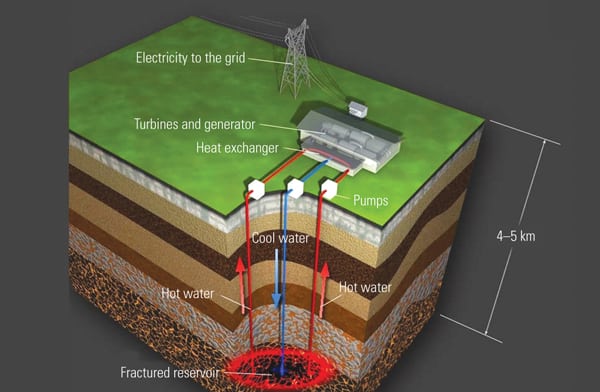A Game-Changing Vision for Geothermal Energy
The post A Game-Changing Vision for Geothermal Energy appeared first on POWER Magazine.

According to a report released in 2019 by the U.S. Department of Energy, geothermal electricity generation could increase more than 26-fold by 2050-reaching 60 GW of installed capacity. That may seem like a pipe dream to some power observers, but if new well-drilling techniques allow enhanced geothermal systems to become economical, the reality could be much greater. In fact, Quaise Energy, a company working to develop enabling technologies needed to expand geothermal on a global scale, claims as much as 30 TW of geothermal energy could be added around the world by 2050.
Most of the geothermal systems that supply power to the grid today utilize hydrothermal resources. These tap into naturally occurring conditions in the Earth that include heat, groundwater, and rock characteristics (such as open fractures that allow fluid flow) for the recovery of heat energy, usually through produced hot water or steam.
Enhanced geothermal systems contain heat similar to conventional hydrothermal resources but lack the necessary groundwater and/or rock characteristics to enable energy extraction without innovative subsurface engineering and transformation. The technology that Quaise Energy is working on would allow drilling down as far as 20 kilometers (12.4 miles) to utilize heat from dry rock formations, which are much hotter and available in almost all parts of the world.
The key thing is we're going for hotter rock, because we want the water to get hotter," Carlos Araque, CEO of Quaise Energy, said as a guest on The POWER Podcast. We want it even to be supercritical, which is the fourth phase of water-when it goes above a certain temperature and pressure-that's what we're looking for."
But drilling to those depths is difficult. It really boils down to temperature," Araque said. The state-of-the-art of drilling technologies is in the 200C neighborhood, and the reason for that is electronics that go with the drilling systems. Making higher-temperature electronics is a very, very difficult task."
Another problem is the hotter the rock gets, the faster drill bits wear out. So, if you imagine drilling at five kilometers below the surface of the earth, your drill bit will only last a few hours, because the rock is so hot and so hard," said Araque. He explained that pulling the drill string out of a five-kilometer-deep hole so that the drill bit can be changed, and then pushing it back into the hole can take a significant amount of time. So, a week to pull out of the hole, a few hours to change the drill bit, a week to push down into the hole to drill a few more hours. It becomes exponentially impossible to do that," he said.
That's where the drilling technology that we're proposing comes into play. We're basically trying to do directed-energy drilling with millimeter waves," Araque said. Imagine a microwave source on the surface, it's called a gyrotron. We beam this energy through a pipe into the hole. Together with this energy, we push a gas-could be nitrogen, could be air, could be argon, if necessary-and at the bottom of that pipe, this energy comes out, evaporates the rock, and the gas picks up the vapor of that rock and pulls it back out. What comes out of the hole looks like volcanic ash, and the hole actually burns its way down, you know, five, six, 10, 15, 20 kilometers, as needed, to get to the temperatures we're looking at."
The fundamental physics behind the technology has been proven, now Quaise Energy is moving from the lab to installing a prototype in the field. Over the next three years, we're going to be working with key people in the oil and gas industry-one of them is one of the largest drilling contractors in the oil and gas industry-and hand in hand working with them to actually show that this is not only a good idea, but it's actually a viable idea. We're going to be doing this in the western United States," said Araque.
The technology has the potential to completely transform the power industry. Araque has a vision of repurposing retired power plants using geothermal energy. What we intend to do is go to existing power plants-it could be a coal power plant, it could be a gas power plant, any of the thousands of fossil-fired power plants that exists in the United States and around the world-and we will propose to them to create a small geothermal field around them, which is matched to the turbine specification of the power plant. What comes out of the ground is steam that feeds into the turbine, and the rest is what they've always done. The turbine creates electricity. The plant is already connected to the grid," said Araque. When the time comes, Araque believes the wells could be drilled in three to five months, making the transition a fairly rapid process. Of course, greenfield projects would also be considered, but those would likely involve more work for permitting and more money for grid connection and other infrastructure.
We want to be able to put gigawatts, tens of gigawatts, hundreds of gigawatts even, into the grid demand every year," said Araque. That's what the energy transition needs, and that's what I think geothermal is very uniquely positioned to do when you do geothermal this way."
To hear the full interview with Araque, listen to The POWER Podcast. Click on the SoundCloud player below to listen in your browser now or use the following links to reach the show page of your favorite podcast platform:
The POWER Podcast 91. A Game-Changing Vision for Geothermal EnergyFor more power podcasts, visit The POWER Podcast archives.
-Aaron Larson is POWER's executive editor (@AaronL_Power, @POWERmagazine).
The post A Game-Changing Vision for Geothermal Energy appeared first on POWER Magazine.